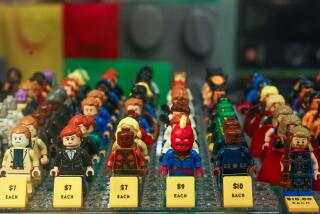Hearts of the City / Exploring attitudes and issues behind the news : Barbie Power
- Share via
In two weeks--actually 12 days for those who are counting--Christmas will arrive. But we need not wait to find out which toy stands astride the Christmas colossus this year. We already know.
It’s Barbie, hands down. After 36 years, a thousand new outfits and a dozen jobs from flippin’ burgers to flying space shuttles, Barbie has climbed her way back to No.1 in the toy world. That’s Barbie of El Segundo, home of Mattel Toys. Blond, full-breasted, Corvette-driving, Southern California Barbie.
You want the numbers on Barbie? Her sales now pump $1 billion per year into Mattel’s treasury. In the United States, there are more Barbies than people. The typical American girl owns eight. Placed head to toe, all the dolls sold would circle the Earth more than six times.
Those are the kind of numbers that once were reserved for McDonald’s hamburgers. Which also, of course, comes from Southern California. But the continuing phenomenon of Barbie presents a mystery far more intriguing than fast food, freeways or any other of Southern California’s timeless contributions to the American culture.
You see, no one really understands Barbie’s mesmerizing power over the psyches of generations of young girls. Other toys, no matter how huge, eventually wear out their appeal. Not Barbie. Mention Barbie to 35-year-old women, even those of a feminist bent, and their eyes go to some faraway place. They start to remember. They will tell you exactly when they got their first Barbie, how they dressed her or whether they let her sleep with Ken. You get about 50/50 on the Ken question. The point is, Barbie takes them somewhere. They feel her power even now.
Today, if you walk into the Christmas maelstrom of a Toys-R-Us, you will see the same look in the eyes of 8-year-olds when they hit the Barbie aisle. They stand still, gazing at the wall of pink, and they get that faraway stare. The circle is unbroken.
Whence that power? The mystery goes very deep, but it must stem, in part, from Barbie’s persona as the archetypal Southern California girl. In her seminal study of Barbie, writer M.G. Lord observed, “It is hard to imagine Mattel Toys headquartered anywhere but in Southern California. Barbie could not have been conceived in Pawtucket, Rhode Island, where Hasbro is located, or Cincinnati, Ohio, where Kenner makes its home. Barbie needed the sun to incubate her or, at least, to lighten her hair.”
*
So when Malibu Barbie gets stacked in Paris toy stores, a surfboard lashed to the back of her convertible, several million French third-graders must have her. When Barbie takes off for the desert in her rec vehicle, 10,000 Boston mothers get wheedled until they cave in and buy her.
As Lord noted in her book on Barbie, this identity with Southern California has not only contributed to her success but created powerful conflicts in the Barbie phenomenon. Namely, many mothers resent Barbie while their daughters love her.
“The extent to which Establishment women are uncomfortable with Barbie reflects the degree to which she embodies West Coast style. . . . It is a clash of East versus West, intellectual culture versus physical culture, rootedness versus deracination. The whole of Southern California is as man-made as Barbie; in her hallowed hot tub, her sacred shower, her sacerdotal spa, she celebrates the miracle of manufactured existence.”
In other words, the cultured moms see Barbie as shallow, a relentless consumer of flashy cars and too-bright clothes. The daughters see Barbie as lots of fun. Perhaps the epitome of the Barbie clash got expressed by Anna Quindlen, former columnist for the New York Times, who wrote once that the only way to get rid of Barbie was to “drive a stake through her silver-lame’d heart.”
*
We should not forget that Barbie committed the additional crime of having those breasts. She not only whips out to Malibu in her pink, trashy sports car, she sports a little cleavage on the way. When Ruth Handler, co-founder of Mattel and creator of Barbie, first tried to sell her to toy stores 36 years ago, many refused to put her on the shelf, claiming that mothers would never buy a doll with breasts for their daughters.
In fact, many mothers did try to keep their daughters away from Barbie, but, as we now know, it did no good. A doll offering freedom, sex and a day at the beach overwhelmed the resistance of one mom after another.
Actually, Barbie’s Southern California credentials go even deeper than that. Her apparent qualities of extreme American-ness amount to something of a fraud, as with so many others here. Handler modeled Barbie after a German doll named Lilli. A doll that was a “men’s toy” in Germany, a pornographic plaything with perfect, Aryan features.
To put it bluntly, Barbie’s predecessor was a whore. Part of Handler’s genius was to see how the sleazy Lilli could be transformed into the fresh, fun-loving, gentle sex tease that is Barbie. A Barbie with no visible trace of her German-ness. Washed clean of her past, like so many of us.
Does that explain why you could now fill the Grand Canyon with all the Barbies that have been sold, and why the young girls still line up by the millions to buy more?
Not a chance. The Barbie mystery looms too large and has gone worldwide. In some profound way, Barbie has linked with our souls and bonded. We don’t know why, and may never know. It’s just that, in Southern California, the Barbie links are stronger, the bonds deeper.






